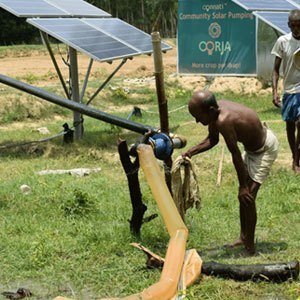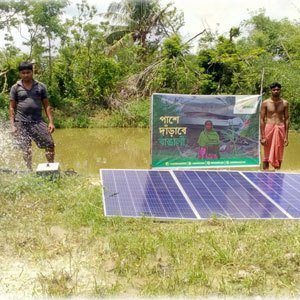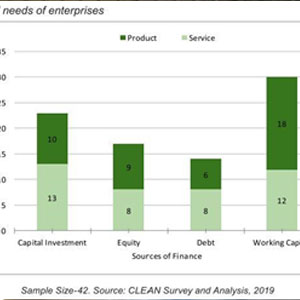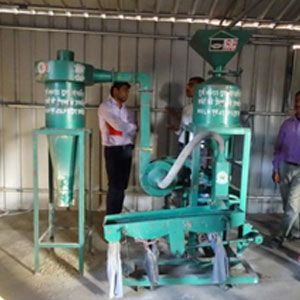Scaling up productive energy through service-based PAYG models
Innovative financing for DRE sector enterprises: Challenges and Solutions
By: Oorja Development Solutions India Private Limited (www.oorjasolutions.org)
The maturity of the off-grid energy market for households has given rise to new markets for solarising productive-use appliances. However, for this market to further scale, there is a need for digitalisation of operations to be able to handle the level of complexity it brings with its unique service delivery model.The energy-agriculture nexus
The agriculture sector is a major source of livelihood, providing income to more than half of the total workforce in India. However, it is starved of the reliable energy sources it needs to act as a motor for poverty alleviation. 86% of India's total farmer population are small and marginal farmers. This means they own less than 2 hectares of land. Irrigation accounts for up to 30% of their total expenses, and is done mainly through electric or diesel-based pumps. With their small landholdings and limited incomes, the majority of farmers cannot invest in more cost-effective technologies such as solar pumps. This is despite capital subsidy schemes such as the Government's KUSUM scheme: though designed for small and marginal farmers, it has benefited mainly those with larger landholdings. Farmers are thus limited to growing rain-fed crops or irrigating sparsely using motor pumps.A dearth of reliable, affordable energy sources also holds back farmers who grow horticulture crops (fruits, vegetables, herbs and flowers). They must sell their produce within a short timespan post-harvest due to the lack of cold-chain infrastructure in most rural areas. Lack of cold chain infrastructure to direct this perishable produce to market has led to nearly one-third of horticulture produce being wasted every year. Investment in the cold chain, specifically in pre-cooling and transport refrigeration equipment, can reduce India's perishable food loss by 76% and CO2e emissions by 16%.
Irrigation and cold chain are just two productive uses of energy that have potential to boost farmer livelihoods and help solve the present agrarian crisis. There are many more such applications and appliances that can be powered by clean energy, particularly solar. What are the solutions available and how can they scale?
New markets in renewable energy
The off-grid solar sector has grown exponentially over the last decade. With over 100 companies providing distributed energy solutions such as solar lamps and solar home systems, this market has matured significantly. Over 108 million people are currently living with improved household energy access from off-grid solar products providing lighting, phone charging, radio and sometimes powering TVs. The sector has attracted over US$1 billion in investments.
The industry has been driven by direct sales or leasing of small PV appliances (typically less than 250 Wp in capacity), whereby end-users own the appliances after 1-2 years. This has been enabled by the disruptive Pay-As-You-Go (PAYG) business model. Consumers pay regular instalments, often using mobile money, rather than paying the full cost of the system up-front. PAYG has emerged as an effective commercially-viable solution to provide decentralised energy access to rural and remote communities in developing nations. It is expected to reach over 10 million customers this year.
The market shift is now towards larger income-generating appliances used in small businesses and farms. This represents a $50 billion market in India alone. It spans various applications such as irrigation, refrigeration and cold storages, agro-processing, poultry incubators, welding, carpentry, tailoring and looming, and many more. PV systems powering productive appliances are typically much larger (>500 and often up to 5000 Wp), and so their upfront cost is significantly larger than for solar lamps or home systems. With target consumers dispersed in rural areas and having limited investment capability, direct purchase of these capital-intensive appliances is prohibitive. Therefore, alternate delivery models are needed.
The rise of service-based PAYG delivery models
Service-based models can be applied across multiple segments in the agriculture value chain to bring access to solar energy services among the most energy-deprived and low-income consumers, including small and marginal farmers.<.
The use of service-based models in the energy sector is not new in India. Many energy utilities, such as those supported by Smart Power India, have installed solar mini-grids providing electricity services to households and small businesses. What is nascent is the use of service-based models for productive energy applications. Irrigation and cold storage are two sectors that are ready for transition to solar energy.
Oorja has deployed a community-based, PAYG solar irrigation service, called Oonnati, for small and marginal farmers. Oorja installs, operates and maintains solar pumping systems for the community, typically of 3-5 kWp capacity. Use of the PAYG model helps making solar pumping affordable to smallholder farmers by avoiding the upfront technology cost barrier. Farmers pay for irrigation services in cash to the local pump operator. This provides farmers access to affordable and reliable year-round access to water and allows them to improve crop yields, grow high-value crops, and increase their income from farming.
As organisations such as Oorja scale, there is a growing need for automation and digitalisation, for instance to facilitate payments and maintenance.
The three dimensions to scale
As the energy access space develops, it needs to focus on becoming 3-dimensional. The 3Ds - Decentralisation, Decarbonisation and Digitalisation - are interlinked trends to solve the energy challenges of developing economies. Enterprises have begun to realise the importance of combining solar power, Internet of Things (IoT) connectivity and digital payments to successfully reach out to a wider population.
Decentralisation and decarbonisation of energy supply is already well underway in India in both urban and rural areas. Urban India has fast-growing utility and rooftop solar markets, and there is an active PV-driven rural electrification sector.
Digitalisation is the next frontier. More than just being a means of collecting payments, embedding smart metering and digital payment systems will allow enterprises to remotely monitor system performance, detect faults, ensure better data collection on customers and impact metrics, and facilitate efficient operation and maintenance. It can also ensure that revenue realisation takes place in accordance with the actual usage of the system.
Digitising payments is still a major hurdle in India, which has a cash-centric economy. While digital payment infrastructure and consumer awareness is growing and there is a positive outlook, rural enterprises such as Oorja are committed to stay ahead of the game in implementing digitally-enabled service-based delivery models to make our energy services more inclusive and provide energy access to economically weaker sections of society.















Posts Comments (0)
Write a Comment
We’ll not publish your email address. Required fields are marked with *